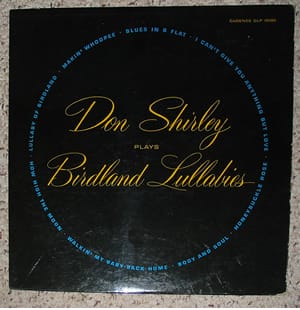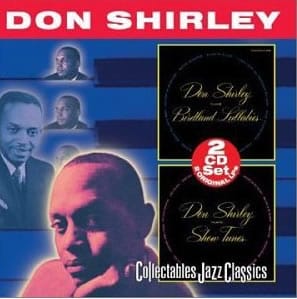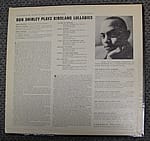 |
1. Lullaby Of Birdland
Recorded at Webster Hall, New York, December 20, 1955, Bass: Richard Davis
2. Makin' Whoopee
Recorded at Webster Hall, New York, December 20, 1955, Bass: Richard Davis
3. Blues In B Flat
Recorded at Webster Hall, New York, December 20, 1955, Bass: Richard Davis
4. I Can't Give You Anything But Love
Recorded at Webster Hall, New York, December 20, 1955, Bass: Richard Davis
5. How High The Moon
Recorded at Webster Hall, New York, December 20, 1955, Bass: Richard Davis
6. Walkin' My Baby Back Home
Recorded at Capitol Studios, New York, December 21, 1957, Basses: Jim Bond and
Kenneth Fricker
7. Body And Soul
Recorded at Capitol Studios, New York, December 21, 1957, Basses: Jim Bond and
Kenneth Fricker
8. Honeysuckle Rose
Recorded at Capitol Studios, New York, December 21, 1957, Basses: Jim Bond and
Kenneth Fricker
Reissued on
Collectable Jazz Classics
COL2790

|
  "WHAT'S the matter--is music sick?" asked four-year
old LeRoy, when his parents introduced Don Shirley
as a "Doctor of Music." Rarely had such an innocent
query so cleanly labeled the ills of post-war
American music. In answer to the child's question,
Don composed Atonal Ostinato Blues In B
Flat, a work poking fun at the jazz heroes of a
decade ago who were confusingly writing immense
arrangements in the atonal idiom . Although a
tongue-in -cheek composition, this work is
classically legitimate and serves as a fine X-ray to
view the musical complexities of the Shirley mind.
"WHAT'S the matter--is music sick?" asked four-year
old LeRoy, when his parents introduced Don Shirley
as a "Doctor of Music." Rarely had such an innocent
query so cleanly labeled the ills of post-war
American music. In answer to the child's question,
Don composed Atonal Ostinato Blues In B
Flat, a work poking fun at the jazz heroes of a
decade ago who were confusingly writing immense
arrangements in the atonal idiom . Although a
tongue-in -cheek composition, this work is
classically legitimate and serves as a fine X-ray to
view the musical complexities of the Shirley mind.
Don 's highly
contrapuntal treatment of George Shearing's
contemporary classic, Lullaby of Birdland, is
an excellent example of mirror counterpoint in a
free rhapsodic style. This delightfully different
interpretation offers ingenious use of
imitation--one voice imitating the other at a higher
or lower
interval. The serious musician also may detect five
different species of counterpoint in this polyphonic
treatment.
The rendition of Johnny
Green's Body and Soul is another contrapuntal
work, arranged here in the Sonatini form. The
continuous on and off beat of the two basses
displays the extraordinary technical competence of
this unique group.
One of the indigenous
Shirley trademarks is the re-casting of a song's
frantic meter into a soothing, if still up-tempo,
arrangement. This may be noted in I Can't Give
You Anything But Love and the usually chaotic
Makin' Whoopee.
Audiences have often commented
that Don never leaves the melody--a high compliment
to an artist who has often left it far behind. In
How High The Moon, the initial bass solo so
firmly establishes the melodic line that one
hears it even when it is not being played . This
ingenious contribution is another example of
extensive use of counterpoint forms.
The highest level of art
has been described as that which can be appreciated
from all perspectives by all levels of maturity.
This album offers numerous examples of Don Shirley's
attempt to reach this universal audience. From the
casual listener who enjoys the pleasant manner of
the unique arrangements
and compositions, to the sophisticated music scholar
who appreciates the complexity of form and the
classical innovations, there is little doubt that
Don Shirley is a creator of pleasure and beauty. |

